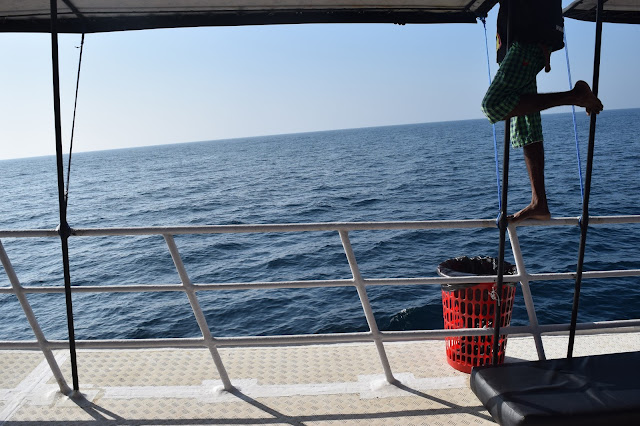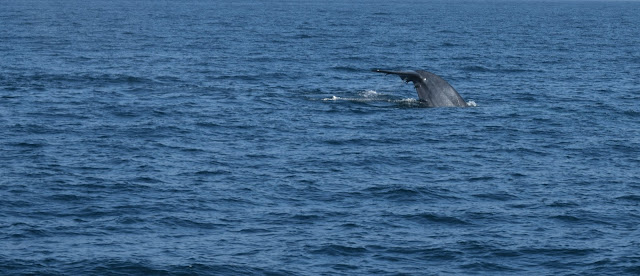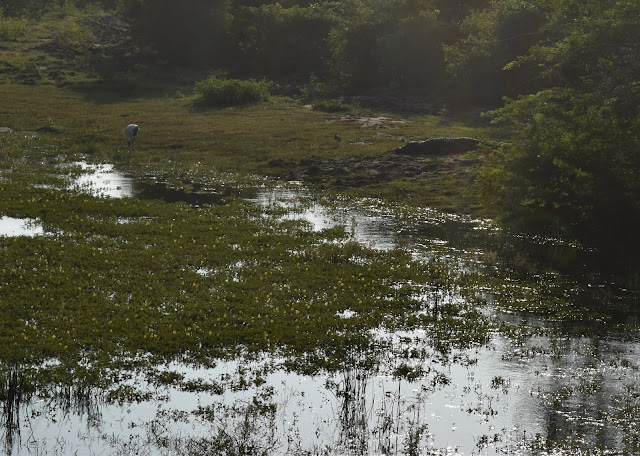We spent Christmas eve and Christmas morning in Mirissa, at the Peacock Villa. After our exhausting drive from Bundala national park, we wanted nothing more than to relax and get some rest before our early whale watching start the next morning. We ate a big meal at the family-run guesthouse across the street (rotis and curries), and then tucked in for the night.
The next morning, our tour, the Mirissa Whale Watching Club , sent a tuk tuk driver (complimentary) at 6:15 am to pick us up from our hotel, which was just wonderful and convenient.
We took our seasickness tablets, boarded the boat, then drank our coffees, ate our breakfasts, tied down our bags, and donned our life jackets.

Before we knew it, we were off and away!
The ocean is so big… we were lucky -- the waters were very calm that day.
Our boat was not crowded at all. This is the top deck, which I vastly preferred to the lower deck.
We saw a sea turtle on the way out, and two sea turtles mating on our way back. No pictures.
We also bumped into a huge group of dolphins, a very playful and fun bunch that eventually raced right up to our boat and did these spectacular jumps.
Dolphins are such fun creatures to watch - they jump so swiftly, easily and effortlessly through the water. It is so fun, especially when they're all jumping simultaneously.
They move so fast that it is really hard to get a picture of more than a blur and some splash.
My favorite, though, were the baby dolphins that launched themselves fully into the air, in full belly flopping glory. What undaunted joy! What pleasure!
After we ooh'd and ahh'ed over the dolphins for a bit, our skipper and boat tour guides got serious. "Time to find the blue whale," they declared solemnly.
And find them we did. What glorious, huge (huge!!) creatures of the deep.
Blue whales do not travel in pods and they are not that keen to be close to humans (complete opposite of our killer whale experience in California), so it is challenging to see one up close. They also barely emerge from the water when breathing, so you can't really see more than a sliver of their back and tail. All of this is to say, this doesn't help us visualize just how big these animals are. It is just really hard to fully comprehend their scale.
For such a large animal, it seems incredibly fluid and graceful.
I mean, look at that clean re-entry into the water! Such finesse.
The tour lasted about five hours - we were back in port by 11:30 a.m. and we were the last boat in the harbor. For 4,000 LKR per person, this was a great experience well worth it. On the one hand, you could say that you don't really see very much. On the other hand, you could say that you just got a glimpse of an endangered species, the largest mammal to have ever lived on Earth, in its natural habitat.
Mirissa is a beautiful beach town. We didn't spend any time on the beach itself, but when we were driving past the ocean on our way to Galle we couldn't stop exclaiming over how beautiful the waves were - long, even breaks, just rolling on and on endlessly. It seemed perfect for surfing. We also saw a lot of the traditional fisherman, sitting on their wood poles, waiting for the tide to come in to cast their lines.
We also loved our stay at the Peacock Villa. Though it was basic, there could not be a kinder, friendlier and more gentle establishment. It seemed like a family owned operation, with an older man and two younger men running the show. They gave us a bag of Christmas presents too (full of candy, tea, and a little carved elephant)!
Peacock Villa
Uluwajjagodawatta, off of Udupila Junction,
Udupila, Mirissa
info@peacockvilla.lk
Whale Watching Club Mirissa
whalewatchingclubmirissa@gmail.com
4,000 LKR per person, including tea/coffee, water, breakfast and fruit, as of Dec. 2015
The next morning, our tour, the Mirissa Whale Watching Club , sent a tuk tuk driver (complimentary) at 6:15 am to pick us up from our hotel, which was just wonderful and convenient.
We took our seasickness tablets, boarded the boat, then drank our coffees, ate our breakfasts, tied down our bags, and donned our life jackets.

Before we knew it, we were off and away!
The ocean is so big… we were lucky -- the waters were very calm that day.
Our boat was not crowded at all. This is the top deck, which I vastly preferred to the lower deck.
We saw a sea turtle on the way out, and two sea turtles mating on our way back. No pictures.
We also bumped into a huge group of dolphins, a very playful and fun bunch that eventually raced right up to our boat and did these spectacular jumps.
Dolphins are such fun creatures to watch - they jump so swiftly, easily and effortlessly through the water. It is so fun, especially when they're all jumping simultaneously.
They move so fast that it is really hard to get a picture of more than a blur and some splash.
My favorite, though, were the baby dolphins that launched themselves fully into the air, in full belly flopping glory. What undaunted joy! What pleasure!
After we ooh'd and ahh'ed over the dolphins for a bit, our skipper and boat tour guides got serious. "Time to find the blue whale," they declared solemnly.
And find them we did. What glorious, huge (huge!!) creatures of the deep.
 |
| Our first sighting - that glorious tail! |
 |
| It is so cool when the tail breaks the otherwise calm, smooth surface of the water |
 |
| We started eagerly scanning the water for any evidence of spray, a telltale sign of the whale emerging for air |
 |
| Other times, you can barely see it, skimming the surface like a long, gray ripple of water |
 |
| The telltale dorsal fin, just before the tail emerges |
 |
| Just how big is this thing? Hard to picture, right? |
I mean, look at that clean re-entry into the water! Such finesse.
The tour lasted about five hours - we were back in port by 11:30 a.m. and we were the last boat in the harbor. For 4,000 LKR per person, this was a great experience well worth it. On the one hand, you could say that you don't really see very much. On the other hand, you could say that you just got a glimpse of an endangered species, the largest mammal to have ever lived on Earth, in its natural habitat.
Mirissa is a beautiful beach town. We didn't spend any time on the beach itself, but when we were driving past the ocean on our way to Galle we couldn't stop exclaiming over how beautiful the waves were - long, even breaks, just rolling on and on endlessly. It seemed perfect for surfing. We also saw a lot of the traditional fisherman, sitting on their wood poles, waiting for the tide to come in to cast their lines.
We also loved our stay at the Peacock Villa. Though it was basic, there could not be a kinder, friendlier and more gentle establishment. It seemed like a family owned operation, with an older man and two younger men running the show. They gave us a bag of Christmas presents too (full of candy, tea, and a little carved elephant)!
Peacock Villa
Uluwajjagodawatta, off of Udupila Junction,
Udupila, Mirissa
info@peacockvilla.lk
Whale Watching Club Mirissa
whalewatchingclubmirissa@gmail.com
4,000 LKR per person, including tea/coffee, water, breakfast and fruit, as of Dec. 2015



















































